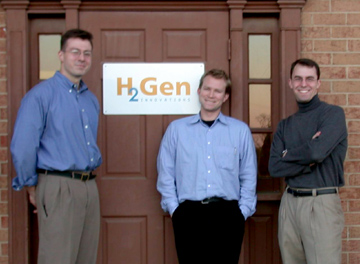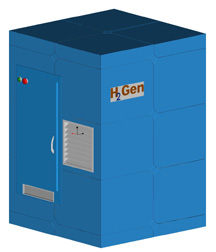|
Web
Exclusives:Features February
27, 2002: At a time when their peers were diving headfirst into the world of dot-com startups, Frank Lomax '95, Erik Bue '96, and John Lettow '95 followed their entrepreneurial dreams in a different direction. Rather than launching the next great Web site, the three engineers pursued a more tangible product: a compact device that turns natural gas into hydrogen. They wanted to create, for the first time, a reliable, inexpensive method to fuel clean-burning, next-generation automobiles. "It's funny when you think about it," Lettow says. "It's pretty mundane — we're basically building a fancy gasoline station. But the impact could be pretty profound. It has the potential to reinvent the country's energy infrastructure." They hope to produce machines that will make and pump hydrogen for next-generation automobiles. Their year-old company — Alexandria, Virginia-based H2Gen Innovations Inc. — has survived the high-tech shakeout with aplomb. In August 2001, H2Gen received $4.7 million in venture-capital funding — enough to last the company "for a while," Bue says. Much of that money came, indirectly, from major energy companies and carmakers; both industries hope that H2Gen's invention can fill a key void in the marketplace. Indeed, with the dot-com market in shambles, the three learned, happily, that to venture capitalists, "boring is now sexy. Investors want to back things that you can touch, things where you can kick the tires. That's refreshing." But over the next four years— often at night and on weekends — Lomax and Bue toyed with the challenge, eventually making some progress on the technical front. A few patents, a business plan, and countless fundraising forays later, they left DTI, amicably, to start H2Gen. Since its founding, the company has grown from six employees to 14 (including Lettow, who had worked with the other two informally before joining full-time last year.) During the past year, the company has demonstrated the technology's feasibility in reduced-scale models. Eventually, they envision a machine that is roughly 7 feet wide, 7 feet deep, and 9 feet tall. Lomax, Bue, and Lettow make a point of combining a concern for the environment with hard-nosed business principles. "One of the most exciting things is that this is societally meaningful," Bue says. But Lomax adds, "you can't rely on the government as a golden goose. You have to compete in the marketplace." While H2Gen is shooting for the moon with its dream of putting hydrogen-based cars in every garage, the company is also pursuing more modest markets including industrial users of hydrogen, facilities like hospitals or apartment buildings that might want to purchase their own generators, and fleets of trucks and buses that can be refueled at central facilities. "The car companies have been spending collectively billions of dollars a year on developing hydrogen-based cars over the last several years," Bue says. "But the one thing that is keeping them from going full-steam ahead is that no one has found an answer to delivering hydrogen fuels at the local gas station." But if H2Gen's system pans out, drivers will be able to swipe their card exactly as they do now at gasoline pumps. The nation's 20,000 gas stations would have to buy the newfangled hydrogen pumps, but they will also be able to use them to generate electricity that they can sell back to electric utilities for profit. Alternately, convenience stores or other businesses could diversify into fuel sales. All that will be needed is a natural gas connection, a water hookup, and an electrical outlet. The company hopes to begin shipping units in mid-2003. The three alums credit their Princeton Engineering School education — which features more theory than the other universities' programs do — with allowing them to think "outside the box." H2Gen designed their technology in a way that cuts the number of key components from 15 to five — the kind of mind-shift, they say, that big industrial engineers are not used to making. All told, Lomax, Bue, and Lettow hope that their technology can cut the cost of building a national hydrogen infrastructure from an estimated $3 trillion to only $4 billion, an amount comparable to the annual upkeep of the nation's gasoline infrastructure. Lettow notes that educating the public about the benefits of hydrogen-based
cars will be "a big challenge." Their more immediate challenge
is educating potential business partners. "We regularly run
into the youth issue," Bue says. "When you first walk
in, you have to work a little harder and have your [stuff] together.
Then people usually warm up. If you've got a good technology and
a good plan, that's what business people are interested in."
By Louis Jacobson '92 Louis Jacobson, a staff correspondent at National Journal magazine, writes frequently about science for the Washington Post and the Economist.
|

 Caption:
From left, Frank Lomax '95, Erik Bue '96 and John Lettow '95
Caption:
From left, Frank Lomax '95, Erik Bue '96 and John Lettow '95 Lomax,
Bue, and Lettow — all engineering majors at Princeton —
knew each other on campus, but they didn't hook up as entrepreneurs
until after graduation. Each worked at one time or another at Directed
Technologies Inc., an engineering consulting firm in Arlington,
Virginia. Six years ago, Lomax's boss at DTI asked him to design
a small appliance to manufacture hydrogen. Knowing that industrial
plants with that capability typically require a city block or more,
Lomax was skeptical.
Lomax,
Bue, and Lettow — all engineering majors at Princeton —
knew each other on campus, but they didn't hook up as entrepreneurs
until after graduation. Each worked at one time or another at Directed
Technologies Inc., an engineering consulting firm in Arlington,
Virginia. Six years ago, Lomax's boss at DTI asked him to design
a small appliance to manufacture hydrogen. Knowing that industrial
plants with that capability typically require a city block or more,
Lomax was skeptical.